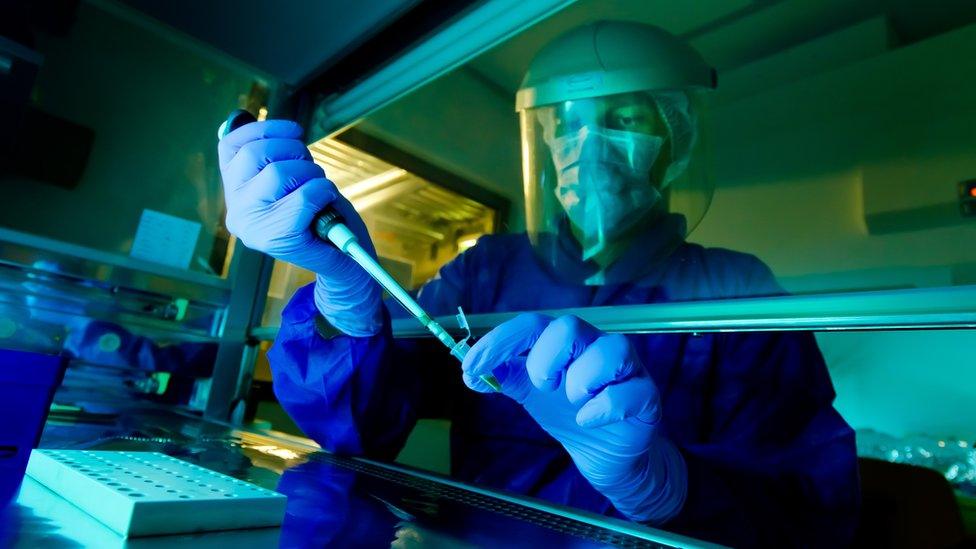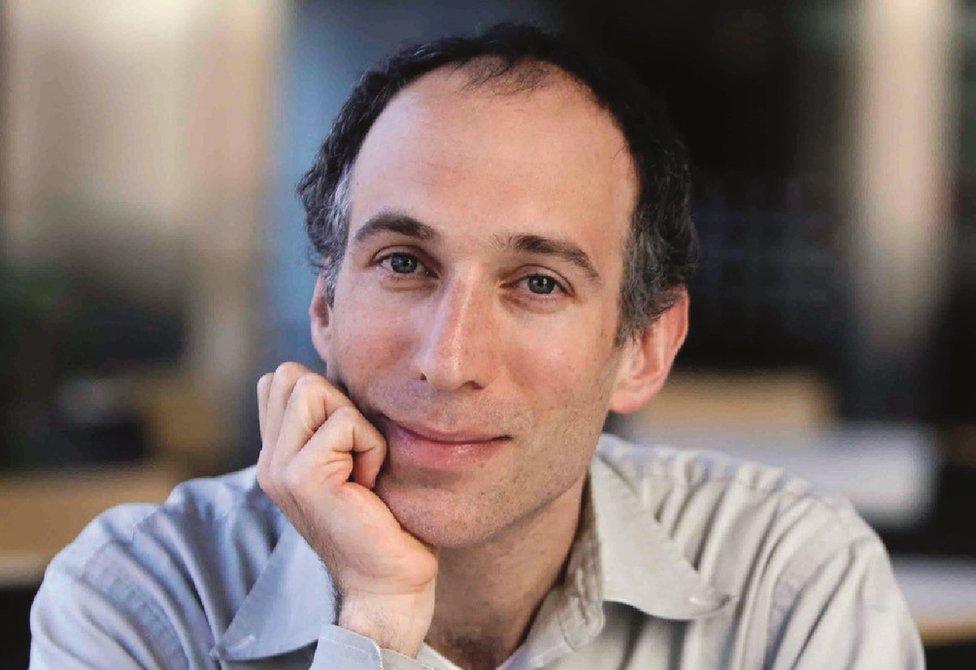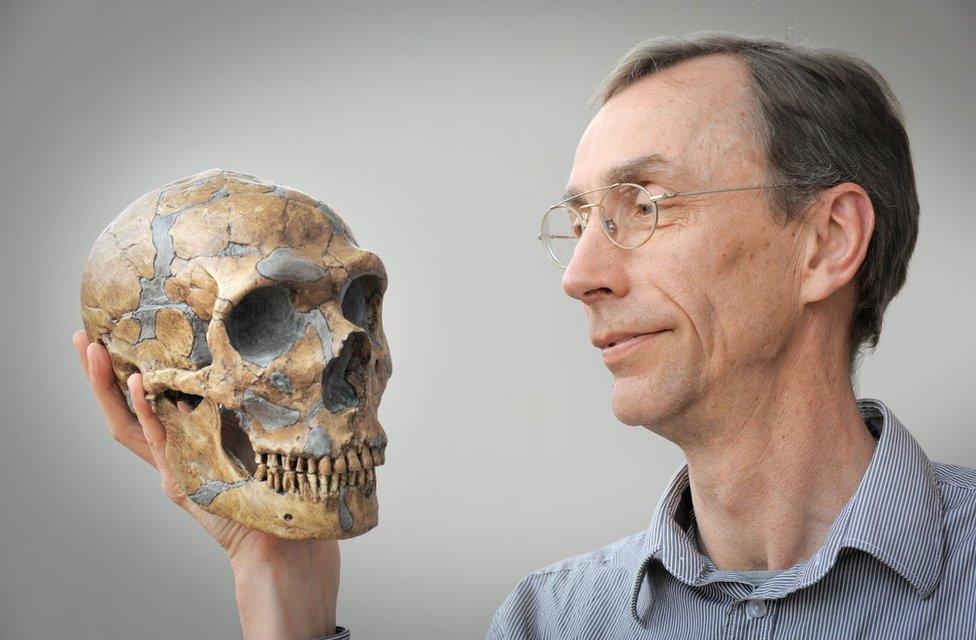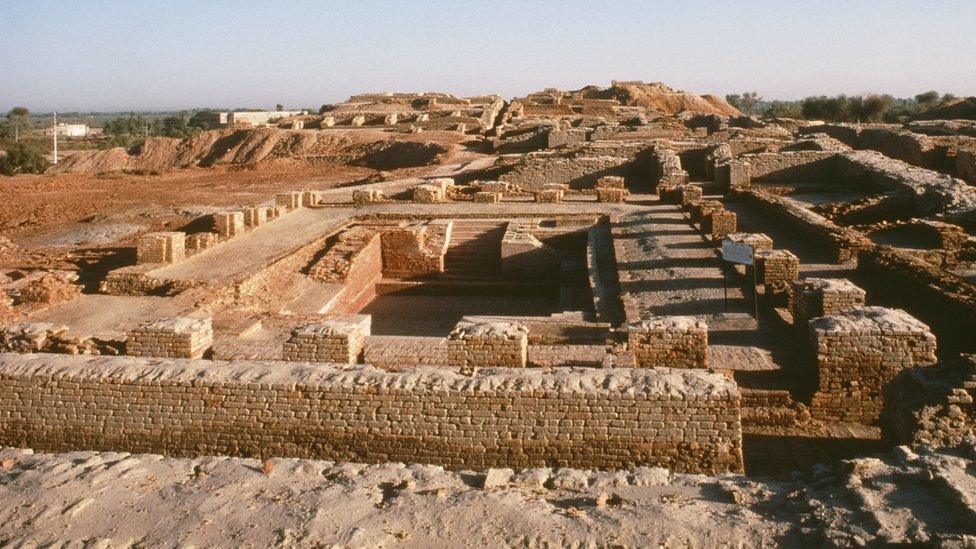How ancient DNA is transforming our view of the past
- Published

Ancient DNA labs maintain strict protocols to prevent contamination of samples with modern genetic material
Prof David Reich of Harvard Medical School is one of the leading lights in the field of ancient DNA. His team's work has cast a new perspective on human history, reconstructing the epic migrations and genetic exchanges that shaped the people of different regions worldwide. Here he explains how this revolution in our understanding unfolded.
If it seems as if there has been an avalanche of recent headlines revealing insights into the travails of our ancient ancestors, you'd be right.
From the fate of the people who built Stonehenge to the striking physical appearance of Cheddar Man, a 10,000-year-old Briton, the deluge of information has been overwhelming.
But this step change in the understanding of our past has been building for years now. It's been driven by new techniques and technological advancements in the study of ancient DNA - genetic information retrieved from the skeletal remains of our long-dead kin.
At the forefront of this revolution is David Reich of Harvard Medical School, external in Boston Massachusetts. I met Prof Reich recently at the BBC while he was in the UK to talk about his book Who We Are and How We Got Here, which draws together the most recent scientific results in this field of study.
The Harvard professor, who is 43, was recently highlighted by the journal Nature as one of 10 people who mattered in all of science, external for his role in transforming the field of ancient DNA from "niche pursuit to industrial process".

David Reich took a risky decision to re-tool his laboratory for ancient DNA work; it paid off
Reich was raised in Washington DC, by parents who were distinguished in their own fields. His mother Tova is a novelist and his father Walter is a professor of psychiatry who also served as the first director of the United States Holocaust Memorial Museum.
"In my family, there was a premium and a strong belief placed on creativity - doing something new and interesting and edgy. Science was seen as the highest thing someone could do," he says. "I had lots of interests, but the things I was most interested in were history and science."
Reich says that he "fell in love" with human evolutionary history at the beginning of his PhD in biochemistry, but then moved away from the subject towards medical genetics. He explained: "The technology at the time really wasn't very good for learning a lot about human history."
Throughout the 1990s and early 2000s, studies of ancient DNA from our own species were highly contentious because of observations that skeletal remains were easily contaminated by the DNA of living people.
As such, there were always nagging doubts about whether a genetic sequence belonged to the long-dead individual being studied or to an archaeologist involved in excavating the remains, a museum curator who had handled them, or a visitor to the lab where they were being analysed.
However, crucial progress in overcoming these obstacles began in the late 90s with the effort to sequence DNA from Neanderthals, which was led by Professor Svante Pääbo at the Max Planck Institute for Evolutionary Anthropology in Leipzig, Germany. , external
Pääbo's group developed a set of protocols to prevent contamination slipping through, including having the same samples sequenced in two laboratories by different teams.

Svante Paabo led the effort to sequence the first genome of a Neanderthal
But the field experienced a revolution with the emergence of so-called next-generation sequencing technology. When an organism dies, the DNA in its cells begins to break down - over time it splits into smaller and smaller chunks, as well as accumulating other forms of damage.
It also gets contaminated with vast amounts of microbial DNA from the wider environment. The new sequencing machines could be used to isolate the human genetic material from bacterial DNA and then stitch together the tiny fragments into a readable sequence.
In 2006, Reich and his close scientific collaborator Nick Paterson were invited by Svante Pääbo to join the Neanderthal genome effort. Pääbo had been particularly impressed by a Nature paper they had authored on the complex separation of the human and chimpanzee evolutionary lineages, external, and thought the techniques they had used would be relevant to the question of whether Neanderthals and modern humans had interbred.
"I was working on the last 10,000 years of human history, reconstructing it on the basis of present-day people, especially in India… it was obvious the ancient DNA techniques that worked in Neanderthals were going to work even better in more recent humans," Reich explains.
"I talked to Svante and he said: 'This is very important but it's not my focus. I'm focused like a laser beam on archaic humans and early modern humans.'"
Reich took a radical decision to completely re-tool his laboratory at Harvard - which had been focused on medical genetics - along the lines of Pääbo's lab in Leipzig.

A late Neolithic mass migration from the steppe gave rise to new archaeological cultures in Europe
"There was a scientist in my laboratory, Nadin Rohland, who had worked in Leipzig (with Svante Pääbo) who knew how to do everything… they helped us to establish this laboratory. It was a big bet that this was a good thing to do."
The bet paid off in a major way. Reich used his next-generation sequencing tech to power through genome after genome. To date, the lab has retrieved DNA from more than 900 ancient individuals.
The results are helping assemble new narratives for the peopling of our world. In some cases, the results have forced archaeologists and historians to re-visit some long-held ideas, sparking no small amount of debate and controversy.
Reich's team has helped unravel the tangled web of migration and interbreeding that set down the present-day genetic landscape of Europe. Archaeologists had long suspected that the spread of farming out of the Near East and across Europe was a formative event in the continent's prehistory.
Reich's work helped confirm that this meeting of rather distantly related Near East farmers and indigenous hunter-gatherers had been crucial to the mix of ancestry that characterises Europeans, but his team added a third key ingredient to the melting pot.
In a paper published in the journal Genetics in 2012, external, Reich and his colleagues had spotted that Northern and Central Europeans appeared to have received genetic input from a population related to Native Americans.
Further evidence from ancient DNA would confirm that this distinctive genetic signature had entered Europe for the first time during a mass migration of people from the steppe, on Europe's eastern periphery.

In Britain, the populations that built Stonehenge builders were largely replaced around 4,500 years ago
These nomadic steppe pastoralists, known as the Yamnaya, moved west in the late Neolithic and Bronze Age, around 5,000 years ago. In some areas of Europe, they replaced around 75% of the ancestry of existing populations.
Theories of large-scale migrations had fallen out of favour over the years among some scholars, particularly those for whom the phrase "pots, not people" (that culture tends to spread via the exchange of ideas rather than large-scale movement) had become a mantra.
But successive papers from the Reich group and other teams working on ancient DNA, such as the one led by Eske Willerslev at the University of Copenhagen, external, showed that mass migrations, with the displacement of earlier populations, were not uncommon in history.
This year, Reich's team published a sprawling study detailing how an archaeological culture known as the Beaker phenomenon transformed the genetic make-up of western and central Europe. In Britain, the Beakers replaced an astonishing 90% of the existing ancestry. The team isn't finished with Britain, Reich is now planning to track changes that occurred in the Iron Age and Roman period.
Conflict, innovations such as horse riding, and the spread of diseases like plague to populations with naïve immune systems might all have played a role in some dispersals.
But the reasons behind these replacements remain a question for archaeologists, says Reich. "I think we're providing data and it vividly portrays the magnitude of these events. Understanding why it happens is a little bit hard for me to say," he explains.
Reich says that his collaborator Nick Paterson's background in mathematics has been "absolutely critical" to teasing out the genetic relationships that underlie many key discoveries.

A recent publication shed light on the epic journeys that led to the peopling of Pacific islands
"My laboratory has two lab heads not one, the other is Nick Paterson. I'm not a serious mathematician: I'm numerate, a data analyst, but not a developer of techniques. Nick is a world class mathematician."
Paterson has an extraordinary biography., external Born in 1947 to Irish parents in London, his talents made him a child maths and chess prodigy. A few years after graduating from Cambridge University, he was recruited to work for the UK's signals intelligence agency GCHQ, where he spent a decade.
After that, he worked for another 10 years at the US equivalent, the National Security Agency (NSA). After leaving the spy world, Paterson worked for the successful New York-based hedge fund Renaissance Technologies, before beginning his collaboration with Reich in 2001.
In the last few years, the Harvard team has also published studies on ancient DNA from Africa, the Middle East and Oceania. Reich is currently finalising a paper on the peopling of South Asia - a longstanding area of interest - which should get published this year. It is likely to be pored over in India, where notions of deep-rooted ancestry are linked to Hindu nationalism.
The Harvard professor recently penned an opinion piece in the New York Times, external which stirred controversy online, highlighting the lack of consensus on how to frame discussions of human biological variation. In his article, Reich comments: "It is important, even urgent, that we develop a candid and scientifically up-to-date way of discussing any such differences, instead of sticking our heads in the sand and being caught unprepared when they are found." Some 67 researchers signed an open letter (published by Buzzfeed), objecting to arguments put forward in the op-ed., external

An advanced civilisation built these structures at Mohenjo Daro in Pakistan; Reich has a long-standing interest in the history of South Asia
For example, the letter says: "Reich critically misunderstands and misrepresents concerns that are central to recent critiques of how biomedical researchers - including Reich - use categories of 'race' and 'population'".
The researchers add: "This doesn't mean that genetic variation is unimportant; it is, but it does not follow racial lines. History has taught us the many ways that studies of human genetic variation can be misunderstood and misinterpreted."
Asked about the criticisms, the Harvard professor told me: "I'm actually very pleased to be part of introducing this discussion. I think that scientists have been anxious about discussing differences among populations in public fora, even though all the work that we do is about differences among populations and learning about their history. The anxiety is about possible misuse of that data - for good reason."
He stressed the need for scientists to take charge of the narrative, lest they hand the initiative to those with less benign intentions. "The thing I have felt very strongly, increasingly over time, is that the fact that scientists are too afraid to speak up about these topics means that the vacuum… gets filled by people who don't really know the scientific facts," he explains.
Prof Reich says that science itself shouldn't be considered immune from the influence of longstanding assumptions. "I think there's a huge opportunity for interpretational bias. I think that the genetic data are very seriously constraining the models that are possible right now," he says.
But, he adds: "There's some advantage to coming at it from the outside... arguably, there's something to be said for a non-Jewish European person studying Jewish population history, or a person from Africa studying East Asian population history... in my lab, I've pushed people to work on areas that are not their own background."
Looking to the future, Prof Reich sees huge potential for uncovering as yet unknown human movements and gene exchange in different parts of the world.
"I think Africa is a place that's deeply under-represented. There are maybe only 20 genome sequences in what is the most diverse place in the world - the place with the deepest and most complex human history," said Prof Reich.
"That compares to more than 1,000 genomes from Europe right now, which is an important but small corner of the world."
He adds: "There's so much to do."
Follow Paul on Twitter., external
Who We Are and How We Got Here by David Reich is published by Oxford University Press.